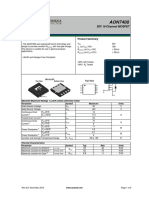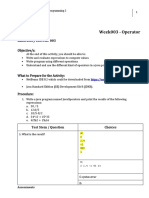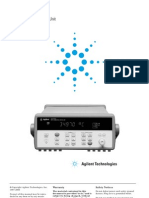General Description Product Summary: 30V P-Channel MOSFET
General Description Product Summary: 30V P-Channel MOSFET
Uploaded by
teranet tbtCopyright:
Available Formats
General Description Product Summary: 30V P-Channel MOSFET
General Description Product Summary: 30V P-Channel MOSFET
Uploaded by
teranet tbtOriginal Description:
Original Title
Copyright
Available Formats
Share this document
Did you find this document useful?
Is this content inappropriate?
Copyright:
Available Formats
General Description Product Summary: 30V P-Channel MOSFET
General Description Product Summary: 30V P-Channel MOSFET
Uploaded by
teranet tbtCopyright:
Available Formats
AON7403
30V P-Channel MOSFET
General Description Product Summary
The AON7403 uses advanced trench technology to VDS -30V
provide excellent RDS(ON), and ultra-low low gate charge ID (at VGS=-10V) -29A
with a 25V gate rating. This device is suitable for use as a RDS(ON) (at VGS=-10V) < 18mW
load switch or in PWM applications.
RDS(ON) (at VGS=-5V) < 36mW
100% UIS Tested
DFN 3x3_EP
Top View Bottom View D
Top View
S 1 8 D
S 2 7 D
S 3 6 D
G 4 5 D
G
Pin 1
S
Absolute Maximum Ratings TA=25°C unless otherwise noted
Parameter Symbol Maximum Units
Drain-Source Voltage VDS -30 V
Gate-Source Voltage VGS ±25 V
Continuous Drain TC=25°C -29
ID
Current TC=100°C -18 A
Pulsed Drain Current C IDM -80
Continuous Drain TA=25°C -11
IDSM A
Current TA=70°C -8.5
Avalanche Current C IAR 24 A
Repetitive avalanche energy L=0.1mH C EAR 29 mJ
TC=25°C 25
PD W
Power Dissipation B TC=100°C 10
TA=25°C 4.1
PDSM W
Power Dissipation A TA=70°C 2.6
Junction and Storage Temperature Range TJ, TSTG -55 to 150 °C
Thermal Characteristics
Parameter Symbol Typ Max Units
Maximum Junction-to-Ambient A t ≤ 10s 22 30 °C/W
RqJA
Maximum Junction-to-Ambient A D Steady-State 47 60 °C/W
Maximum Junction-to-Lead Steady-State RqJC 4.2 5 °C/W
Rev.4.0: November. 2013 www.aosmd.com Page 1 of 5
Electrical Characteristics (TJ=25°C unless otherwise noted)
Symbol Parameter Conditions Min Typ Max Units
STATIC PARAMETERS
BVDSS Drain-Source Breakdown Voltage ID=-250mA, VGS=0V -30 V
VDS=-30V, VGS=0V -1
IDSS Zero Gate Voltage Drain Current mA
TJ=55°C -5
IGSS Gate-Body leakage current VDS=0V, VGS= ±25V 100 nA
VGS(th) Gate Threshold Voltage VDS=VGS ID=-250mA -1.7 -2.2 -3 V
ID(ON) On state drain current VGS=-10V, VDS=-5V -80 A
VGS=-10V, ID=-8A 14 18
mW
RDS(ON) Static Drain-Source On-Resistance TJ=125°C 20 25
VGS=-5V, ID=-5A 26 36 mW
gFS Forward Transconductance VDS=-5V, ID=-8A 20 S
VSD Diode Forward Voltage IS=-1A,VGS=0V -0.7 -1 V
IS Maximum Body-Diode Continuous Current -22 A
DYNAMIC PARAMETERS
Ciss Input Capacitance 1130 1400 pF
Coss Output Capacitance VGS=0V, VDS=-15V, f=1MHz 240 pF
Crss Reverse Transfer Capacitance 155 pF
Rg Gate resistance VGS=0V, VDS=0V, f=1MHz 5.8 8 W
SWITCHING PARAMETERS
Qg(10V) Total Gate Charge 18 24 nC
Qgs Gate Source Charge VGS=-10V, VDS=-15V, ID=-8A 5.5 nC
Qgd Gate Drain Charge 3.3 nC
tD(on) Turn-On DelayTime 8.7 ns
tr Turn-On Rise Time VGS=-10V, VDS=-15V, RL=1.8W, 8.5 ns
tD(off) Turn-Off DelayTime RGEN=3W 18 ns
tf Turn-Off Fall Time 7 ns
trr Body Diode Reverse Recovery Time IF=-8A, dI/dt=500A/ms 12 16 ns
Qrr Body Diode Reverse Recovery Charge IF=-8A, dI/dt=500A/ms 26 nC
A. The value of RqJA is measured with the device mounted on 1in2 FR-4 board with 2oz. Copper, in a still air environment with TA =25°C. The
Power dissipation PDSM is based on R qJA t ≤ 10s value and the maximum allowed junction temperature of 150°C. The value in any given
application depends on the user's specific board design, and the maximum temperature of 150°C may be used if the PCB allows it.
B. The power dissipation PD is based on TJ(MAX)=150°C, using junction-to-case thermal resistance, and is more useful in setting the upper
dissipation limit for cases where additional heatsinking is used.
C. Repetitive rating, pulse width limited by junction temperature TJ(MAX)=150°C. Ratings are based on low frequency and duty cycles to keep
initial TJ =25°C.
D. The RqJA is the sum of the thermal impedence from junction to case RqJC and case to ambient.
E. The static characteristics in Figures 1 to 6 are obtained using <300ms pulses, duty cycle 0.5% max.
F. These curves are based on the junction-to-case thermal impedence which is measured with the device mounted to a large heatsink, assuming
a maximum junction temperature of TJ(MAX)=150°C. The SOA curve provides a single pulse rating.
G. The maximum current rating is package limited.
H. These tests are performed with the device mounted on 1 in2 FR-4 board with 2oz. Copper, in a still air environment with TA=25°C.
THIS PRODUCT HAS BEEN DESIGNED AND QUALIFIED FOR THE CONSUMER MARKET. APPLICATIONS OR USES AS CRITICAL
COMPONENTS IN LIFE SUPPORT DEVICES OR SYSTEMS ARE NOT AUTHORIZED. AOS DOES NOT ASSUME ANY LIABILITY ARISING
OUT OF SUCH APPLICATIONS OR USES OF ITS PRODUCTS. AOS RESERVES THE RIGHT TO IMPROVE PRODUCT DESIGN,
FUNCTIONS AND RELIABILITY WITHOUT NOTICE.
Rev.4.0: November. 2013 www.aosmd.com Page 2 of 5
TYPICAL ELECTRICAL AND THERMAL CHARACTERISTICS
80 80
-10V VDS=-5V
-8V
-6V
60 60
-ID(A)
-ID (A)
40 40
-4.5V
125°C
20 20 25°C
VGS=-4V
0 0
0 1 2 3 4 5 1 2 3 4 5 6
-VDS (Volts) -VGS(Volts)
Fig 1: On-Region Characteristics (Note E) Figure 2: Transfer Characteristics (Note E)
40 1.6
Normalized On-Resistance
35 VGS=-10V
ID=-8A
VGS=-5V 1.4
30
RDS(ON) (mW)
17
25 1.2
5
20
2
VGS=-10V 1 10
15 VGS=-5V
ID=-5A
10 0.8
0 5 10 15 20 0 25 50 75 100 125 150 175
-ID (A)
Figure 3: On-Resistance vs. Drain Current and Gate Temperature (°C) 0
Voltage (Note E) Figure 4: On-Resistance vs. Junction
18Temperature
(Note E)
50 1.0E+01
ID=-8A
40 1.0E+00
40
RDS(ON) (mW)
125°
-IS (A)
30 1.0E-01 125°
25°
25°
20 1.0E-02
10 1.0E-03
2 4 6 8 10 0.0 0.2 0.4 0.6 0.8 1.0 1.2
-VGS (Volts) -VSD (Volts)
Figure 5: On-Resistance vs. Gate-Source Voltage Figure 6: Body-Diode Characteristics (Note E)
(Note E)
Rev.4.0: November. 2013 www.aosmd.com Page 3 of 5
TYPICAL ELECTRICAL AND THERMAL CHARACTERISTICS
10 1600
VDS=-15V
ID=-8A 1400
8 Ciss
1200
Capacitance (pF)
1000
-VGS (Volts)
6
800
4 600
Coss
400
2
200
Crss
0 0
0 5 10 15 20 0 5 10 15 20 25 30
Qg (nC) -VDS (Volts)
Figure 7: Gate-Charge Characteristics Figure 8: Capacitance Characteristics
1000.0 10000
TA=25°
100.0 10ms
1000
RDS(ON)
-ID (Amps)
10.0 100ms
Power (W)
1ms 100
1.0
DC 10ms
TJ(Max)=150°C 100ms
TA=25°C 10
0.1 10s
0.0 1
0.01 0.1 1 10 100 0.00001 0.001 0.1 10 1000
-VDS (Volts) Pulse Width (s)
Figure 9: Maximum Forward Biased Safe Figure 10: Single Pulse Power Rating Junction-to-
Operating Area (Note F) Ambient (Note F)
10
D=Ton/T In descending order
ZqJA Normalized Transient
TJ,PK=TA+PDM.ZqJA.RqJA D=0.5, 0.3, 0.1, 0.05, 0.02, 0.01, single pulse
Thermal Resistance
1 RqJA=60°C/W
0.1
PD
0.01
Ton
T
Single Pulse
0.001
0.00001 0.0001 0.001 0.01 0.1 1 10 100 1000
Pulse Width (s)
Figure 11: Normalized Maximum Transient Thermal Impedance (Note F)
Rev.4.0: November. 2013 www.aosmd.com Page 4 of 5
Gate Charge Test Circuit & Waveform
Vgs
Qg
- -10V
VDC
-
+ Vds Qgs Qgd
VDC
+
DUT
Vgs
Ig
Charge
Resistive Switching Test Circuit & Waveforms
RL
Vds ton toff
td(on) tr td(off) tf
Vgs
-
Vgs DUT VDC
Vdd 90%
Rg
+
Vgs 10%
Vds
Unclamped Inductive Switching (UIS) Test Circuit & Waveforms
2
L EAR= 1/2 LIAR
Vds
Id Vds
- BVDSS
Vgs
Vgs VDC
Vdd
Rg
+ Id
I AR
DUT
Vgs Vgs
Diode Recovery Test Circuit & Waveforms
Vds + Q rr = - Idt
DUT
Vgs
t rr
Vds - L -Isd -I F
Isd dI/dt
+ Vdd -I RM
Vgs VDC
Vdd
Ig
- -Vds
Rev.4.0: November. 2013 www.aosmd.com Page 5 of 5
You might also like
- White Paper My SAP ERP CGMPDocument44 pagesWhite Paper My SAP ERP CGMPfurqan.malik100% (1)
- Samsung Bn44-00517c Pslf790d04a Parts InfoDocument15 pagesSamsung Bn44-00517c Pslf790d04a Parts InfoDodi Gak DodolNo ratings yet
- General Description Product Summary: 30V P-Channel MOSFETDocument6 pagesGeneral Description Product Summary: 30V P-Channel MOSFETluis alberto perez monteroNo ratings yet
- AONR21357 ReemplazoDocument6 pagesAONR21357 ReemplazoDavid Enrique Rivero CahuichNo ratings yet
- General Description Product Summary: 30V N-Channel MOSFETDocument6 pagesGeneral Description Product Summary: 30V N-Channel MOSFETSergio PerezNo ratings yet
- AON7430Document6 pagesAON7430deyvid sanchezNo ratings yet
- Datasheet 3Document6 pagesDatasheet 3alan segundo garcia chotaNo ratings yet
- General Description Product Summary: 30V N-Channel MOSFETDocument6 pagesGeneral Description Product Summary: 30V N-Channel MOSFETSomendra SinghNo ratings yet
- General Description Product Summary: 30V N-Channel AlphamosDocument6 pagesGeneral Description Product Summary: 30V N-Channel AlphamosDavid SimonNo ratings yet
- AON7548Document6 pagesAON7548Ahmad AmerNo ratings yet
- AON6414A: General Description Product SummaryDocument6 pagesAON6414A: General Description Product SummaryJuanes MuñozNo ratings yet
- General Description Product Summary: 30V N-Channel AlphamosDocument6 pagesGeneral Description Product Summary: 30V N-Channel AlphamosDenis DenisovNo ratings yet
- AON7410Document6 pagesAON7410Leandro OliveiraNo ratings yet
- AON7523Document6 pagesAON7523jawareh.libyaNo ratings yet
- AON7430 30V N-Channel MOSFET: General Description FeaturesDocument6 pagesAON7430 30V N-Channel MOSFET: General Description FeaturesE GNo ratings yet
- General Description Product Summary: 30V N-Channel MOSFET SdmosDocument7 pagesGeneral Description Product Summary: 30V N-Channel MOSFET SdmosCleiton SilvaNo ratings yet
- AON6514Document6 pagesAON6514Cezao DoidãoNo ratings yet
- AON6504Document6 pagesAON6504Mar GaoNo ratings yet
- AON7408Document6 pagesAON7408aldo_suviNo ratings yet
- Aons 32314Document6 pagesAons 32314Акмаль КадыровNo ratings yet
- DtaSheet Aol 1448Document6 pagesDtaSheet Aol 1448Emerson VieiraNo ratings yet
- AON6552Document6 pagesAON6552Dorel ComlosanNo ratings yet
- AON6502Document6 pagesAON6502dentronikNo ratings yet
- AON6710 - N-Channel Enhancement Mode Field Effect TransistorDocument5 pagesAON6710 - N-Channel Enhancement Mode Field Effect TransistorLangllyNo ratings yet
- General Description Product Summary: 30V N-Channel AlphamosDocument6 pagesGeneral Description Product Summary: 30V N-Channel AlphamosDenis DenisovNo ratings yet
- General Description Product Summary: 30V N-Channel MOSFETDocument6 pagesGeneral Description Product Summary: 30V N-Channel MOSFETTsukamoto TsukushiNo ratings yet
- AOD4184A: General Description Product SummaryDocument6 pagesAOD4184A: General Description Product SummaryAriel dajaoNo ratings yet
- AON6372Document6 pagesAON6372Akhmad MukhsinNo ratings yet
- Aon6978 PDFDocument10 pagesAon6978 PDFKakang NggaNo ratings yet
- General Description Product Summary: 30V Dual P-Channel MOSFETDocument5 pagesGeneral Description Product Summary: 30V Dual P-Channel MOSFETAENo ratings yet
- General Description Product Summary: 30V N-Channel AlphamosDocument6 pagesGeneral Description Product Summary: 30V N-Channel AlphamosGarcia F. MarcioNo ratings yet
- AOD420 N-Channel Enhancement Mode Field Effect Transistor: Features General DescriptionDocument5 pagesAOD420 N-Channel Enhancement Mode Field Effect Transistor: Features General Descriptionwillian GaldinoNo ratings yet
- AON7408 30V N-Channel MOSFET: Features General DescriptionDocument4 pagesAON7408 30V N-Channel MOSFET: Features General DescriptionJose Fernandes CanalesNo ratings yet
- AONR32320CDocument6 pagesAONR32320CJalu JajangkarNo ratings yet
- AONS21321: General Description Product SummaryDocument6 pagesAONS21321: General Description Product SummaryStoica VictorNo ratings yet
- Aos Aonr32340cDocument7 pagesAos Aonr32340crafael villalobosNo ratings yet
- Aon7410 PDFDocument6 pagesAon7410 PDFGilson3DNo ratings yet
- Features General Description: 30V N-Channel MOSFETDocument6 pagesFeatures General Description: 30V N-Channel MOSFETKrista TranNo ratings yet
- General Description Product Summary: 30V N-Channel MOSFETDocument5 pagesGeneral Description Product Summary: 30V N-Channel MOSFETaffes electroniqueNo ratings yet
- AON7506Document6 pagesAON7506aldo_suviNo ratings yet
- General Description Product Summary: 30V N-Channel MOSFETDocument6 pagesGeneral Description Product Summary: 30V N-Channel MOSFETRobson ZimmermannNo ratings yet
- DatasheetDocument5 pagesDatasheetcody 2No ratings yet
- General Description Product Summary: 30V N-Channel MOSFETDocument5 pagesGeneral Description Product Summary: 30V N-Channel MOSFETTaufik MantofaniNo ratings yet
- General Description Product Summary: 30V N-Channel MOSFETDocument6 pagesGeneral Description Product Summary: 30V N-Channel MOSFETAntonioPeriniNo ratings yet
- AOTF4126Document7 pagesAOTF4126José Mauro Costa MacedoNo ratings yet
- Aon 7702Document6 pagesAon 7702Agung HaryantoNo ratings yet
- Srfet: Product Summary General DescriptionDocument5 pagesSrfet: Product Summary General DescriptionShamim DhaliNo ratings yet
- Aon 6926Document10 pagesAon 6926Hermilio ValdizanNo ratings yet
- Aod 2908Document6 pagesAod 2908Electronica SiracusaNo ratings yet
- AO4710 AlphaOmegaSemiconductorsDocument6 pagesAO4710 AlphaOmegaSemiconductorsanggie machoNo ratings yet
- General Description Product Summary: 30V P-Channel MOSFETDocument6 pagesGeneral Description Product Summary: 30V P-Channel MOSFETCarlos Luis ColmenaresNo ratings yet
- AO4409 Mosfet para Ampli Bluetooth ChinoDocument5 pagesAO4409 Mosfet para Ampli Bluetooth ChinoAnival FabregasNo ratings yet
- General Description Product Summary: 30V Dual P-Channel MOSFETDocument6 pagesGeneral Description Product Summary: 30V Dual P-Channel MOSFETbiomed2083No ratings yet
- AOD484 N-Channel Enhancement Mode Field Effect Transistor: Features General DescriptionDocument5 pagesAOD484 N-Channel Enhancement Mode Field Effect Transistor: Features General DescriptionkalanghoNo ratings yet
- AOD452A N-Channel SDMOS POWER Transistor: General Description FeaturesDocument7 pagesAOD452A N-Channel SDMOS POWER Transistor: General Description FeaturesFacundo GarcesNo ratings yet
- AOL1412-Alpha - Omega-SemiconductorDocument6 pagesAOL1412-Alpha - Omega-Semiconductormuhammad talqiNo ratings yet
- AON6908A: General Description Product SummaryDocument11 pagesAON6908A: General Description Product SummaryLuis SantosNo ratings yet
- Mosfet Doble Superficial Canal N 30V 8amp AO4854Document6 pagesMosfet Doble Superficial Canal N 30V 8amp AO4854Antonio ChavezNo ratings yet
- AOD452A N-Channel SDMOS POWER Transistor: General Description FeaturesDocument7 pagesAOD452A N-Channel SDMOS POWER Transistor: General Description FeaturesAlexsandro TorezinNo ratings yet
- Design of Electrical Circuits using Engineering Software ToolsFrom EverandDesign of Electrical Circuits using Engineering Software ToolsNo ratings yet
- SSAP Software For Advanced LEM AnalysisDocument49 pagesSSAP Software For Advanced LEM AnalysisriccecriNo ratings yet
- Answer Week003 Labex1Document9 pagesAnswer Week003 Labex1Audie Mar AgpawaNo ratings yet
- Product Data Sheet 6AU1435-2AD00-0AA0: PLC and Motion Control PerformanceDocument5 pagesProduct Data Sheet 6AU1435-2AD00-0AA0: PLC and Motion Control PerformanceChristian GonzalezNo ratings yet
- Sensenutsuniversity PDFDocument4 pagesSensenutsuniversity PDFMusaddique DangeNo ratings yet
- 21 WordPress Interview Questions and Answers (II) For ExperiencedDocument8 pages21 WordPress Interview Questions and Answers (II) For Experiencedjatinkant123No ratings yet
- Simulation of Kaduna Refining and Petrochemical Company (KRPC) Crude Distillation Unit (CDU I) Using HysysDocument7 pagesSimulation of Kaduna Refining and Petrochemical Company (KRPC) Crude Distillation Unit (CDU I) Using HysysAdhityaEkoBagusNo ratings yet
- SAP IDES Installation Manual 4.7Document82 pagesSAP IDES Installation Manual 4.7sagiinfo1No ratings yet
- AIS Chapter 9Document12 pagesAIS Chapter 9Trish CalumaNo ratings yet
- Bush 1207 RadioDocument23 pagesBush 1207 RadioP BNo ratings yet
- Gronsund07 Masterthesis AFieldStudyOfWiMAXPerformanceDocument198 pagesGronsund07 Masterthesis AFieldStudyOfWiMAXPerformanceMetla14No ratings yet
- وزاري انكلش وحلوله - عباسDocument20 pagesوزاري انكلش وحلوله - عباسAhmedA.HassanNo ratings yet
- Intel Nuc Kit Nuc5Ppyh: Product BriefDocument4 pagesIntel Nuc Kit Nuc5Ppyh: Product BriefkishanNo ratings yet
- Agilent 34970aDocument440 pagesAgilent 34970ajulioga09No ratings yet
- Geoinformatics 2010 Vol02Document60 pagesGeoinformatics 2010 Vol02protogeografoNo ratings yet
- Comparison and Assessment of Using Primavera and Microsoft Project in Construction Projects in Erbil CityDocument8 pagesComparison and Assessment of Using Primavera and Microsoft Project in Construction Projects in Erbil CitybrinthamrNo ratings yet
- 8-Input NAND Gate: Integrated CircuitsDocument8 pages8-Input NAND Gate: Integrated CircuitsJHON EDWARD LIZARAZO PARADANo ratings yet
- Lab10 Homepage MockupDocument1 pageLab10 Homepage MockupjinyannnNo ratings yet
- Assignement No. 4 (MCP)Document7 pagesAssignement No. 4 (MCP)Shahrooz WaleedNo ratings yet
- Setting Up WAN Emulation Using WAN-Bridge Live-CD v1.10 PDFDocument8 pagesSetting Up WAN Emulation Using WAN-Bridge Live-CD v1.10 PDFp2pavanNo ratings yet
- BS Iso 02219-2010Document34 pagesBS Iso 02219-2010Ahmed SalehNo ratings yet
- Technical Seminar Titles NewDocument6 pagesTechnical Seminar Titles NewGovardhan Babu GnikNo ratings yet
- PPT6 - Dynamic Programming Multistage Graph & Travelling Salesman ProblemDocument23 pagesPPT6 - Dynamic Programming Multistage Graph & Travelling Salesman ProblemAditya wahyu50% (2)
- APM PSRAM QSPI APS6404L SQN v3 6 PKG-1954836Document25 pagesAPM PSRAM QSPI APS6404L SQN v3 6 PKG-1954836ManunoghiNo ratings yet
- Spray Currency Dispenser Service Manual: B006-6280-A000 April 2002Document142 pagesSpray Currency Dispenser Service Manual: B006-6280-A000 April 2002Benni Mohamed AmineNo ratings yet
- Cambridge International AS & A Level: Computer Science 9608/13Document12 pagesCambridge International AS & A Level: Computer Science 9608/13AsimNo ratings yet
- AimbotDocument8 pagesAimbotinayatullaharain0333No ratings yet
- Mesh-Intro 14.5 L07 Assembly MeshingDocument32 pagesMesh-Intro 14.5 L07 Assembly Meshinganmol6237No ratings yet
- Le Lac Alphonse de Lamartine DissertationDocument7 pagesLe Lac Alphonse de Lamartine DissertationBuyDissertationPaperCanada100% (1)
- Implementation of Iot Based Patient Health Monitoring System Using Esp32 Web ServerDocument11 pagesImplementation of Iot Based Patient Health Monitoring System Using Esp32 Web ServerIJAR JOURNAL100% (1)

























































































